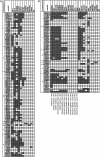Single nucleotide polymorphisms in wild isolates of Caenorhabditis elegans
- PMID: 11076854
- PMCID: PMC310957
- DOI: 10.1101/gr.gr-1471r
Single nucleotide polymorphisms in wild isolates of Caenorhabditis elegans
Abstract
Caenorhabditis elegans (isolate N2 from Bristol, UK) is the first animal of which the complete genome sequence was available. We sampled genomic DNA of natural isolates of C. elegans from four different locations (Australia, Germany, California, and Wisconsin) and found single nucleotide polymorphisms (SNPs) by comparing with the Bristol strain. SNPs are under-represented in coding regions, and many were found to be third base silent codon mutations. We tested 19 additional natural isolates for the presence and distribution of SNPs originally found in one of the four strains. Most SNPs are present in isolates from around the globe and thus are older than the latest contact between these strains. An exception is formed by an isolate from an island (Hawaii) that contains many unique SNPs, absent in the tested isolates from the rest of the world. It has been noticed previously that conserved genes (as defined by homology to genes in Saccharomyces cerevisiae) cluster in the chromosome centers. We found that the SNP frequency outside these regions is 4.5 times higher, supporting the notion of a higher rate of evolution of genes on the chromosome arms.
Figures




References
-
- Abdul Kader N, Cote MG. Isolation, identification and characterization of some strains of Caenorhabditis elegans (Maupas, 1900) from Quebec. Fund App Nemat. 1996;19:381–389.
-
- Adams MD, Celniker SE, Holt RA, Evans CA, Gocayne JD, Amanatides PG, Scherer SE, Li PW, Hoskins RA, Galle RF, et al. The genome sequence of Drosophila melanogaster. Science. 2000;287:2185–2195. - PubMed
-
- Anderson P. Mutagenesis. In: Epstein HF, Shakes DC, editors. Methods in cell biology. Caenorhabditis elegans: Modern biological analysis of an organism. San Diego, CA: Academic Press; 1995. pp. 31–48.
Publication types
MeSH terms
Substances
LinkOut - more resources
Full Text Sources
Other Literature Sources
